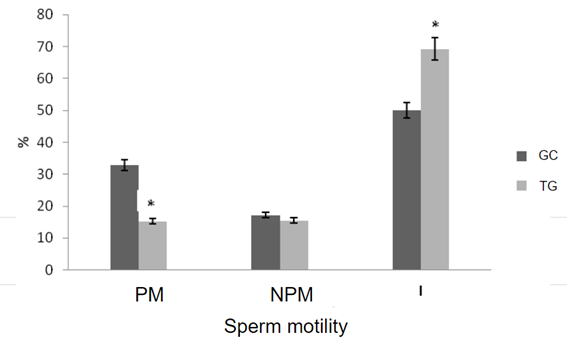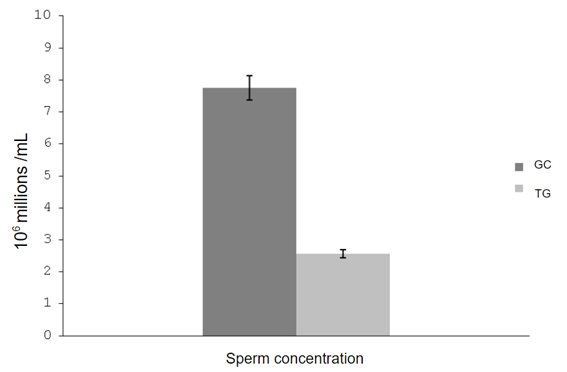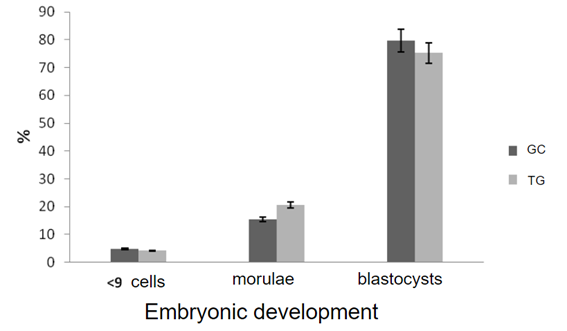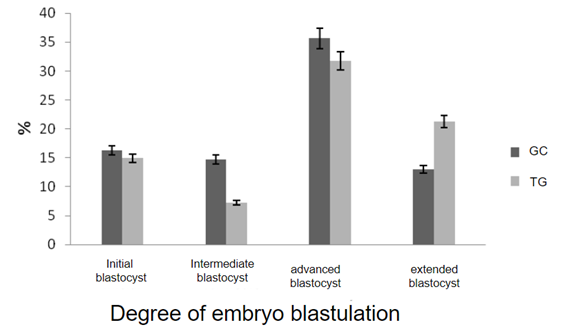ARTICULO ORIGINAL
REVISTA DE LA FACULTAD DE MEDICINA HUMANA 2022 - Universidad Ricardo Palma10.25176/RFMH.v22i4.5115
MAYTENUS MACROCARPA "CHUCHUHUASI" DECREASE THE FERTILITY AND SPERM QUALITY IN MICE
MAYTENUS MACROCARPA “CHUCHUHUASI” DISMINUYE LA CALIDAD ESPERMÁTICA Y LA FERTILIDAD EN RATONES
Jonathan Vásquez Cavero1,2,a, Pilar Pino Velásquez1,a,b, José Gonzáles Daga1,a,c, Eduardo Pulido-Murillo3,d, José Pino Gaviño1,a
1Laboratorio de Reproducción y Biología del Desarrollo. Facultad de Ciencias Biológicas. Universidad Nacional Mayor de San Marcos. Lima-Peru.
2Laboratorio de Fisiología de la Reproducción Animal. Facultad de Ciencias Biológicas. Universidad Nacional Mayor de San Marcos. Lima-Peru.
3Instituto de investigaciones en ciencias biomédicas. Facultad de medicina humana. Universidad Ricardo Palma. Lima, Peru
aBiologist
bMaster in Assisted Reproduction Procedures.
cMaster in Molecular Biology.
dClinical pathologist
ABSTRACT
Introduction: Maytenus macrocarpa (MM) "Chuchuhuasi" is a native plant from the Amazon region of South America, widely used in traditional medicine due its anti-inflammatory, analgesic and anti-tumor properties. However, its effects on reproductive physiology and male fertility have not been elucidated. Methods: Preclinical experimental study of cases and controls. Male mice with eight weeks from birth were administered orally for 70 days (two spermatogenic cycles) an aqueous extract MM: GC (n = 8) 0 mg / kg body weight (bw) control group and treated group GT (n = 8) 1000 mg / kg bw. Later the animals were euthanized, the reproductive organs were weighted, also motility and sperm count were recorded. During the days 60 or 65 of treatment, males were mated and pregnant females were sacrificed on the fourth day of pregnancy for evaluating development, quality, and degree of blastulation. Results: The weights of reproductive organs did not differ significantly between the two groups (p> 0.05). However, progressive motility (32.81 vs. 15.27 ± 4.17% ± 2.08%) and sperm count (7.75 ± 0.34 x 106 / ml vs. 2.56 ± 0.42 x 106 / ml) decreased significantly between GC and GT, respectively. 87.5% (7/8) of the pregnant mice produced 15 litters (GC) and only 50% (4/8) of the pregnant GT yields 4 litters. However, no significant differences were found in the percentage of blastocyst stage embryos, good quality embryos, or embryos with greater than 50% the size of the embryo between the two groups (p> 0.05) blastoceles. Conclusion: the aqueous extract of Maytenus macrocarpa (1000 mg/kl) could have possessed anti-reproductive action in male mice.
Keywords: Spermatic parameters, Embryos classification, Aqueous extract, Fertility, Maytenus macrocarpa. (Source: MeSH NLM).
RESUMEN
Introduccion: Maytenus macrocarpa (MM) "Chuchuhuasi", es una planta nativa de la región Amazónica de Sudamérica ampliamente usada en la medicina tradicional por sus propiedades antiinflamatoria, analgésica y antitumoral. Sin embargo, sus efectos sobre la fisiología reproductiva y la fertilidad masculina aún no han sido elucidados. Metodos: Estudio experimental preclinico de caso y controles. A ratones machos de ocho semanas se les administró oralmente por 70 días (dos ciclos espermatogénicos) el extracto acuoso de MM: grupo control GC (n=8) 0 mg/kg peso corporal (pc) y al grupo tratado GT (n=8) 1000 mg/kg pc. Posteriormente los animales fueron eutanizados, se registraron el peso de los órganos reproductivos, la movilidad y concentración espermática. Durante los días 60 a 65 del tratamiento los machos se aparearon y las hembras preñadas se sacrificaron al cuarto de día de preñez para la evaluación del desarrollo, calidad y grado de blastulación de los embriones. Resultados: Los pesos de los órganos reproductivos no variaron significativamente entre ambos grupos (p>0.05). Sin embargo, la movilidad progresiva (32,81 ± 4,17 % vs. 15,27 % ± 2,08) y concentración espermática (7,75 ± 0,34 x 106/ml vs. 2,56 ± 0,42 x 106/ml) disminuyeron significativamente entre GC y GT, respectivamente. El 87,5% (7/8) de ratones del GC preñaron produciendo 15 camadas y del GT sólo el 50% (4/8) preñaron produciendo 4 camadas. Sin embargo, no se encontraron diferencias significativas en el porcentaje de embriones en estadío de blastocisto, embriones de buena calidad, ni en embriones con blastocele mayor al 50% del tamaño del embrión entre ambos grupos (p>0.05). Conclusión: el extracto acuoso de Maytenus macrocarpa (1000 mg/kl) podría poseer acciónes anti-reproductiva en ratones machos.
Palabras Clave: Calidad espermática, Embriones, Extracto acuoso, Fertilidad, Maytenus macrocarpa. (fuente: DeCS BIREME).
INTRODUCTION
Plants and their active compounds have been used as an important source of medicines to treat various diseases. The therapeutic potential of most of these plants is based on their anti-cancer, anti-diabetic, hepatoprotective, cardioprotective, analgesic, and other pharmacological properties(1) . However, some plants may adversely affect different physiological functions, including male reproductive function, whose adverse effects have been attributed mainly to anti-spermatogenic and anti-steroidogenic properties of one or more active compounds. (2-5) We should consider the importance of the study of medicinal plants because approximately 75-80% of the world's population consumes them(6) and in Peru 1400 species of plants are used for medicinal purposes, whose widespread use has been recorded for thousands of years(7) .
Celastraceae is a large family of trees and shrubs, there are approximately 89 genera and 1300 species that have been used for centuries for the treatment of stomach complications, fever, rheumatism, and cancer(8) . The Celastraceae family is recognized in Peru for having eight genera and 29 species(9) and Maytenus is one of the largest genera(10) and its plants are used in traditional medicine in South America as infusions(11) . The metabolites of the genus Maytenus are mainly tripertenos(12,13) and flavonoids.(14) The biological activity of several Maytenus species has been demonstrated: M. ilicifolia as a contraceptive, anti-inflammatory and antioxidant(15,16) ; M. krukovii presents antioxidant, antimutagenic and antimicrobial activity(17) ; M. aquifolium, analgesic properties(18) ; M. senegalensis has antibacterial, antiviral, antitumor activity(19,20,21) and M. macrocarpa acts as a cytotoxic(22) and antimicrobial agent(23) .
Maytenus macrocarpa Ruiz and Pav. (Chuchuhuasi) is a native plant of the Amazonian region of Peru, its bark is generally used as an aguardiente for the treatment of rheumatism, influenza, and gastrointestinal diseases and as an antitumor agent(24) . There is scarce information on the effects of plants of the genus Maytenus on the reproductive system in mammals; Montanari et al.,(25) provided daily doses of 800 mg/kg bw of the ethanolic extract of M. ilicifolia to mice and microscopic analysis of the seminiferous tubules showed no abnormalities. However, at daily doses of 1000 mg/kg bw the hydroalcoholic extract of M. ilicifolia interfered negatively with embryonic implantation in mice.
The present study aims to evaluate the implications of Maytenus macrocarpa aqueous extract (1000 mg/kg bw) intake during 2 spermatogenic cycles (70 days) on reproductive parameters and fertility in mice.
METHODS
Design and study area
Preclinical experimental case-control study, experimental biology area.
Population and sample
The sample consisted of 20 male mice (Mus musculus) of the BALB/c strain of 8-10 weeks of age, the case (experimental) group consisted of 10 mice, which were administered aqueous extract through nasogastric tube N°18 (Fisher Scientific, Pittsburgh, PA, USA), at a concentration of 1000 mg/kg body weight for 70 days. The control group consisted of 10 mice that received distilled water by the same route. All were kept in a temperature-controlled room (22-25°C) with 14/10 h light/dark cycles, and water and mouse chow were provided ad libitum.
Variables
Independent variables: Sex (male, female, treatment male mice, pregnant females day 1 and day 4, weight pregnant females day 1 and day 4, presence of corpus luteum, number of embryos, embryo grade, embryo stage.
Dependent variables: reproductive quality of the male mouse, preimplantation embryonic development. A data collection form was made with all the variables of the research study where the findings were recorded.
Procedures
1. Preparation of aqueous extract: Maytenus macrocarpa was purchased from PromoAgro export SAC (Lima, Peru). The aqueous extract was prepared from the dried and powdered material of the bark. 100 g of Chuchuhuasi was heated (90-100 °C) for 30 minutes in 1 L of water. It was then cooled at room temperature overnight and the next day the supernatant was filtered twice with sterile Whatman filter paper (40µm and 20 µm) until a paste was obtained.
The paste was dissolved in distilled water. The final volume of the extract (100 mg-ml ) was aliquoted into 1.5 ml vials and stored at 4° C until use.
2. Treatment: Mice were divided into two groups; the Treatment Group (TG) (n=10) was administered Maytenus macrocarpa aqueous extract (1000 mg/kg bw) and the Control Group (CG) (n=10) was administered distilled water (vehicle) for 70 days. The aqueous extract of M. macrocarpa and distilled water were administered using an esophageal probe N°18 (Fisher Scientific, Pittsburgh, PA, USA). Body weight was recorded every 7 days and after treatment the animals were euthanized by cervical dislocation. The weight of the reproductive organs: testes, epididymis and prostate were recorded using an analytical balance with 0.001 g sensitivity. Spermatozoa were obtained from the tail of the epididymis and sperm motility and concentration were analyzed according to WHO (2010).
Obtaining epididymis and spermatozoa: Each of the epididymides obtained were washed with phosphate-buffered saline (PBS pH 7.4) at 37°C, several cuts were made in the tail of the epididymis and then the spermatozoa were released for 10 minutes in 0.5 ml of Flushing culture medium (MediCult®, Copenhagen, Denmark), the sperm content was recovered in its entirety in 1.5 ml polypropylene tubes (Axygen Scientific).
4. Evaluation of sperm motility: A drop of sperm sample (10 ul) was placed on a slide at 37°C in an incubator with CO2 and directly observed at 400 X in a phase contrast microscope (AJ Seitz, San Francisco, U.S.A). This procedure was performed twice, the results presented are the average of both evaluations, being evaluated at least 200 spermatozoa. Spermatozoa were considered to have Progressive Mobility (PM) when they moved, Non-Progressive Mobility (NPM) when they did not move and only had an in situ movement, and Immotile (I) when they did not show any type of movement(6) .
Sperm concentration measurement: Sperm concentration was calculated using a 1:20 dilution, 10 µl of the sample was diluted with 190 µl of sodium bicarbonate(6) . The Neubauer chamber was then loaded, allowed to sediment for 5 minutes and the spermatozoa were counted within the fields defined in the chamber (5 quadrants), using a phase contrast microscope at 400X, the number of spermatozoa observed was multiplied by the corresponding factor (106 ). Sperm concentration was expressed in millions/ml.
3. Fertility: During days 60-65 of treatment, 01 male mouse was placed at night (20:00-21:00 hours) with two six-week-old virgin females in estrus or estrus phase during the whole night and the following morning (9:00-10:00 hours) the presence or absence of the vaginal plug was visualized, the presence of the vaginal plug was considered as day 1 of pregnancy. The pregnant mice were sacrificed on the fourth day of gestation, then the uterine horns and oviducts were perfused, and the embryos were recovered to evaluate: development, quality and degree of blastulation.
Obtaining and evaluation of preimplantation embryos: Mice 4 days pregnant were euthanized by cervical dislocation. The uterine horns and oviducts were dissected to obtain and evaluate their embryos and the ovaries were dissected to count corpora lutea.
Embryo evaluation: Uterine horns and oviducts were perfused with Flushing culture medium (MediCult®, Copenhagen, Denmark), to obtain embryos. Subsequently, embryo development, embryo quality and degree of blastulation were evaluated.
Embryo development: They were classified according to the stage of preimplantational embryonic development(26) :
Delayed stage: Less than 9 cells per embryo.
Morula: More than 8 cells with signs of compaction.
Blastocyst stage: More than 32 compact cells and the presence of blastocele.
Embryo quality: An embryo grading system proposed by Dorn & Kramer(27) and subsequently described by Dawson et al.(26) . This method classifies embryos into four different categories:
Grade I: The embryo shows homogeneous, symmetrical blastomeres without fragmentation.
Grade II: The embryo presents some free blastomeres and some fragments of cytoplasm may be present.
Grade III: The embryo presents free, asymmetric blastomeres with severe malformations.
Grade IV or degenerated: The embryo is bowl-shaped, almost no defined blastomeres are observed and the cell membrane is broken.
Blastulation grade: According to the size of the blastocele, embryos were classified as follows:
Initial Blastocyst: Blastocele occupies less than 30% of the embryo size.
Intermediate Blastocyst: Blastocele occupies between 30% and 50% of the embryo size.
Advanced Blastocyst: Blastocele occupies between 50% and 90% of the embryo size.
Expanded Blastocyst: Blastocele occupies more than 90% of the embryo size.
STATISTICAL ANALYSIS
The homoscedasticity (equality of variances) of the data was tested using Levene's test. To check whether the data obtained for the different variables to be evaluated were normally distributed, the Shapiro-Wilk test was performed. When the variable to be evaluated had a normal distribution, the means were compared with t-Student, otherwise, the Mann-Whitney U test was applied for nonparametric tests. The results were expressed as mean ± SE (standard error). The SPSS Ver 17.00 statistical program was used, considering a significance level of p≤ 0.05.
Ethical aspects
Animal care and handling were performed in accordance with the ethical guidelines of our institution.
RESULTS
Body weight and reproductive organs.
No significant differences were observed in the increase in body weight, testicular, epididymal, vas deferens and prostate weight (p>0.05) between the two groups. The results are summarized in Table 1.
Table 1. Body and reproductive organ weights.
| CG | TG | |
|---|---|---|
| n | ||
| Weight left testicle | 0,1066 ± 0,0054 | 0,1180 ± 0,0058 |
| Left epididymal weight | 0,0401 ± 0,0012 | 0,0410 ± 0,0013 |
| Weight of left vas deferens | 0,0133 ± 0,0010 | 0,0137 ± 0,0030 |
| Weight right testicle | 0,1121 ± 0,0046 | 0,1239 ± 0,0062 |
| Right epididymal weight | 0,0413 ± 0,0012 | 0,0424 ± 0,0014 |
| Right vas deferens weight | 0,0138 ± 0,0010 | 0,0138 ± 0,0005 |
| Weight Prostate | 0,0513 ± 0,0022 | 0,0428 ± 0,0029 |
Sperm motility and concentration
In the WG with respect to the CG, PM was significantly decreased (15.27 ± 2.08 vs. 32.81 ± 4.17, p<0.05) and immotile spermatozoa were significantly increased (69.25 ± 4.17 vs. 50.05 ± 3.77, p<0.05). NPM was not altered (17.14 ± 3.48 vs. 15.48 ± 3.09, p>0.05) between both groups. Figure 1.

Regarding sperm concentration in the epididymal tail, it decreased in the TG with respect to the CG (2.56 ± 0.42 vs. 7.75 ± 0.34, p<0.05). Figure 2.

Fertility
Of the CG, 87.5% (7/8) of the males impregnated females and produced 15 litters and of the TG, only 50% (4/8) of the males impregnated females and produced four litters (Table 2).
Table 2. Fertility evaluation in both groups.
| CG | TG | |
|---|---|---|
| Fertility | 87,5 (7/8) | 50,0 (4/8) |
| Pregnant Females | ||
| Embryos per Litter | 9,27 ± 0,66 | 9,75 ± 1,11 |
Evaluations of pregnant females are summarized in Table 3.
Table 3. Characteristics of the females.
| CG | TG | |
|---|---|---|
| Number of females evaluated | ||
| Total number of embryos analyzed | ||
| Number of corpora lutea | 10,26 ± 0,50 | 11,25 ± 0,85 |
| Number of embryos per litter | 9,26 ± 0,65 | 9,75 ± 1,10 |
Although the aqueous extract of Maytenus macrocarpa decreased fertility because fewer males became pregnant (Table 2 and Table 3), the quality, development and degree of blastulation did not differ between the two groups (Figure 3, 4 and 5).
Regarding the embryos obtained, no significant differences were found in the percentage of blastocysts (79.69 ± 5.25 % vs. 75.23 ± 12.00 %), morulae (15.42 ± 4.30 % vs. 20.61 ± 9.55 %) and embryos with less than 9 cells (4.87 ± 2.40 % vs. 4.17 ± 1.35 %) between GC and GT, respectively (p'0.05) (Figure 3).

No significant differences were found in the percentage of grade I (80.64 ± 5.28 % vs. 79.40 ± 9.55 %), grade II (8.63 ± 2.36 % vs. 10.61 ± 7.87 %), grade III (2.96 ± 2.96 % vs. 10.00 ± 10.00 %) and grade IV or degenerated (7.76 ± 3.69 % vs. 0.00 ± 0.00 %) embryos between GC and GT, respectively (p'0.05) (Figure 4).

No significant differences were found in the percentage of blastocysts: initial (16.29 ± 5.82 % vs. 14.91 ± 3.61 %), intermediate (14.72 ± 4.40 % vs. 7.27 ± 4.75 %), advanced (35.63 ± 5.08 % vs. 31.77 ± 8.62 %) and expanded (13.05 ± 4.24 % vs. 21.28 ± 12.00 %) blastocysts (p'0.05) (Figure 5).

DISCUSSION
The present study investigated the effect of Maytenus macrocarpa on reproductive parameters and fertility in mice. The use of some plants as male contraceptives has been postulated(2,3,5), and should exert a localized effect at the level of the reproductive system, and not a systemic effect that may alter other physiological functions.(28,29,30) The present work suggests the direct action of Maytenus macrocarpa on the reproductive system because there is no modification of body weight (Table 1, p>0.05), while the values of sperm motility and concentration decreased (Figure 1 and 2, respectively, p<0.05), and fertility also decreased after treatment with Maytenus macrocarpa (Table 2). The testes, epididymis, and prostate are androgen-dependent organs(31), we did not observe any modification of their weights, so Maytenus macrocarpa would not be exerting an anti-androgenic effect on the male reproductive system.(32).
Maytenus species possess a large amount of phenolic metabolites such as triterpenes(12,13) and flavonoids(14) , justifying their potent anti-inflammatory action(33,34) . Based on our results, it is suggested that these molecules could be responsible for the decrease in reproductive parameters as it has been reported that triterpene molecules strongly inhibit sperm motility(35) and stop spermatogenesis in rats(36) as well as having a potent inhibitory effect on prostaglandin E2(37) ; this lipid molecule is of great importance on sperm motility(38) by increasing it(39) , it also induces the entry of calcium into the spermatozoon prior to the acrosomal reaction(40) . In turn, flavonoids have been shown to inhibit sperm motility(35) and acrosomal activity(41) . Nor-triterpenes known as macrocarpins have also been reported in Maytenus macrocarpa which possesses strong cytotoxic activity(22) , so these molecules could also be responsible for the decrease in reproductive characteristics after ingestion of Maytenus macrocarpa.
In contrast to our results, Montanari et al.(24) observed through histological sections of mouse testes, that the ingestion of daily doses of 800 mg/kg bw of the ethanolic extract of M. ilicifolia for 30 days did not alter spermatogenesis, which could indicate that the action of Maytenus macrocarpa could be at the post-testicular level, that is, during the transit of spermatozoa through the epididymis. Other possibilities are that the effect of the plants of the genus Maytenus is species-specific and/or specific to the type of extract used, as different types of action have been reported in other plants according to the extract used(42) . Since we used an aqueous extract and Montanari et al(24) an ethanolic extract, we suggest that one or more highly polar compounds may be responsible for the anti-reproductive effects observed.
The dosage time (30 days) used by Montanari et al.(24) would not be the reason why no effects on spermatogenesis were observed because in a previous work(43) we observed that the intake for only 7 days of Maytenus macrocarpa decreased sperm quality in mice, this would support our observation that Maytenus macrocarpa would exert its effect on spermiation and transport in the epididymis because these phenomena occur in a period of 7 days.(44).
While sperm cytoplasmic deficiencies can be detected as early as in a one-cell embryo(45) , deficiencies occurring at the genomic level of the sperm cannot be detected in the embryo before the 8-cell stage of embryo development(46,47) , because of this, we decided to evaluate the blastocyst stage embryo. We found a relationship between the genetic integrity of the spermatozoon and cleavage during the embryo development process(48,49) and the absence of negative effects in the blastocyst stages of the Treatment Group corresponding to pregnant females which could indicate that the ingestion of the aqueous extract of M. macrocarpa does not affect the genetic integrity of the spermatozoon, allowing a normal embryonic development. These results are in agreement with previous studies where there is no toxic effect on species of the genus Maytenus(50,52) , on the other hand, antimutagenic properties have been reported in the genus Maytenus.(17)
Many plant contraceptives act by decreasing sperm motility and concentration in the tail of the epididymis(28,29) , characteristics of great importance for reproductive success(53) , as observed with the aqueous extract of Maytenus macrocarpa.
The limitations of the study were mainly of an institutional logistical nature, such as power outages or untimely closure of the university, which prevented dosing or evaluation at the agreed time, having to repeat the entire dosing process.
CONCLUSION
The ingestion of Maytenus macrocarpa aqueous extract could decrease sperm motility and concentration, as well as fertility in mice. As for the embryos obtained, no significant differences were found between the stages studied. It is evident that further studies are needed to identify which compounds would be responsible for its anti-reproductive effects.
Authorship contributions: The authors participated in the genesis of the idea, project design, development, data collection and interpretation, analysis of results, and preparation of the manuscript.
Funding sources: Vicerrectorado de Investigación de la Universidad Nacional Mayor de San Marcos (Multidisciplinary Project Grant # PEM2008A02).
Conflicts of interest: The authors declare that they have no conflict of interest in the publication of this article.
Received: May 06, 2022
Approved: August 25, 2022
Correspondence: José Luis Rafael Pino Gaviño.
Address: 375 German Amézaga Ave., Cercado Lima-Peru.
Telephone number: 992169186
E-mail: jpinog@unmsm.edu.pe
Article published by the Journal of the faculty of Human Medicine of the Ricardo Palma University. It is an open access article, distributed under the terms of the Creatvie Commons license: Creative Commons Attribution 4.0 International, CC BY 4.0(https://creativecommons.org/licenses/by/1.0/), that allows non-commercial use, distribution and reproduction in any medium, provided that the original work is duly cited. For commercial use, please contact revista.medicina@urp.edu.pe.
REFERENCES
